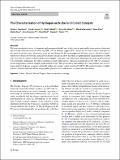The characterisation of hydrogen on nickel and cobalt catalysts
Abstract
We have investigated a series of supported and unsupported nickel and cobalt catalysts, principally using neutron vibrational spectroscopy (inelastic neutron scattering, INS). For an alumina supported Ni catalyst we are able to detect hydrogen on the metal for the first time, all previous work has used Raney Ni. For an unsupported Ni foam catalyst, which has similar behaviour to Raney Ni but with a much lower density, the spectra show that there are approximately equal numbers of (100) and (111) sites, in contrast to Raney Ni that shows largely (111) sites. The observation of hydrogen on cobalt catalysts proved to be extremely challenging. In order to generate a cobalt metal surface, reduction in hydrogen at 250–300 °C is required. Lower temperatures result in a largely hydroxylated surface. The spectra show that on Raney Co (and probably also on a Co foam catalyst), hydrogen occupies a threefold hollow site, similar to that found on Co(101¯0). The reduced surface is highly reactive: transfers between cells in a high quality glovebox were sufficient to re-hydroxylate the surface.
Citation
Davidson , A L , Lennon , D , Webb , P B , Albers , P W , Berweiler , M , Poss , R , Roos , M , Reinsdorf , A , Wolf , D & Parker , S F 2021 , ' The characterisation of hydrogen on nickel and cobalt catalysts ' , Topics in Catalysis , vol. 64 , no. 9 , pp. 644-659 . https://doi.org/10.1007/s11244-021-01425-0
Publication
Topics in Catalysis
Status
Peer reviewed
ISSN
1572-9028Type
Journal article
Collections
Items in the St Andrews Research Repository are protected by copyright, with all rights reserved, unless otherwise indicated.

